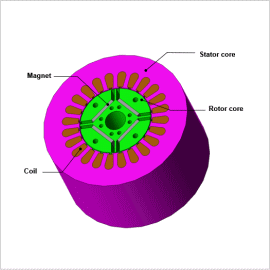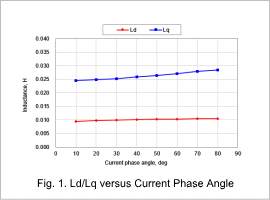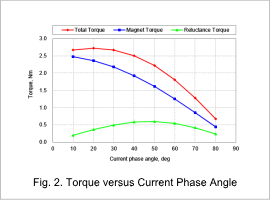*Please prepare a license ID and password for the license administrator.
*It is different from the service for JMAG WEB MEMBER (free membership). Please be careful.
Overview

An IPM motor can use both magnet torque and reluctance torque, so by appropriately choosing the current phase it is possible to improve efficiency over a broad spectrum of drive range. It is a motor type that is often used in equipment with a wide operational range, from air compressors in air conditioners to motors that power vehicles. In many cases, strong rare earth magnets are used to increase output density, so it is necessary to have an IPM motor design that accounts for magnetic circuit saturation.
For this reason a study that considers the influence of saturation needs to be carried out in order to evaluate the IPM motor’s design, so the study ends up carefully investigating variations in inductance characteristics due to current phase, geometry, or the material’s nonlinear magnetic properties. An analysis based on the magnetic circuit method or a theoretical equation that assumes linear properties cannot predict these functions with good accuracy and therefore cannot derive them. Consequently, in order to perform an advanced projection of an IPM motor’s design, an electromagnetic field simulation that uses the finite element method (FEM) is necessary.
In this example, how to obtain the current phase angle characteristics of a dq axis inductance that accounts for magnetic saturation and flux leakage in an IPM motor.
For this reason a study that considers the influence of saturation needs to be carried out in order to evaluate the IPM motor’s design, so the study ends up carefully investigating variations in inductance characteristics due to current phase, geometry, or the material’s nonlinear magnetic properties. An analysis based on the magnetic circuit method or a theoretical equation that assumes linear properties cannot predict these functions with good accuracy and therefore cannot derive them. Consequently, in order to perform an advanced projection of an IPM motor’s design, an electromagnetic field simulation that uses the finite element method (FEM) is necessary.
In this example, how to obtain the current phase angle characteristics of a dq axis inductance that accounts for magnetic saturation and flux leakage in an IPM motor.
Inductance
Fig. 1 shows that the d-axis inductance is smaller because the magnetic flux penetrates through the low permeability magnet. It is less affected by magnetic saturation due to very large magnetic resistance. On the other hand, the q-axis inductance is larger than the d-axis inductance due to larger permeability, and it is also significantly affected by magnetic saturation because the magnetic resistance is much smaller.
Fig. 2 shows that the maximum torque for this IPM motor can be obtained when the current phase angle is around 20 deg.




